Barron Falls

Beez Neez now Chy Whella
Big Bear and Pepe Millard
Fri 24 Jun 2016 22:37
|
Barron Falls Train Stop and
Skyrail Lookout
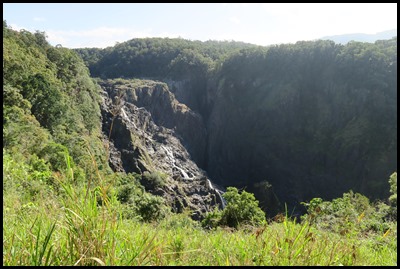 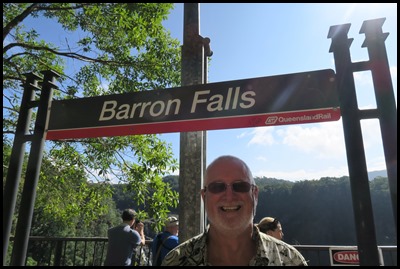 Our first look at the Barron Falls was when the Kuranda Scenic Train stopped for
us all to enjoy the scenery.
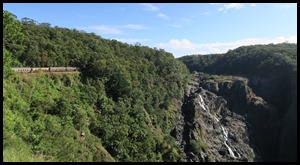 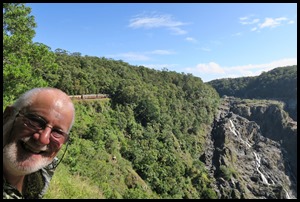 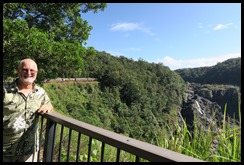 The train,
the photo-bomber and the poser.
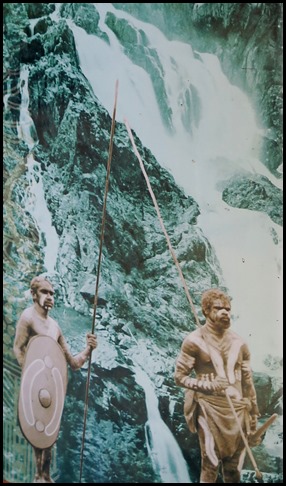 The sign at the stop said: “Bama
Djabuganyaji Gulam Nyina-Nyina Yinu Gudjani Galgarr.” Djabugay People Have Lived Here from Long Ago. In a time
long before European civilisations plied the oceans in search of new lands,
Aboriginal Australians flourished throughout this continent.
They occupied this vast and
diverse country, from the mountains and forest to the coastal, beaches and
islands. From generation to generation customs, laws and traditions linked the
people with land and the land with people and its time and place of creation.
While environments may have varied a common spiritual view of the world and its
creation is present, a view which is truly uniquely Australian, grounded in the
country’s many living qualities, its natural features and its people both past
and present.
Amongst the tribes of the
Rainforest are the Djabuganydji (Tjapukai), whose traditional country you are
now located in.
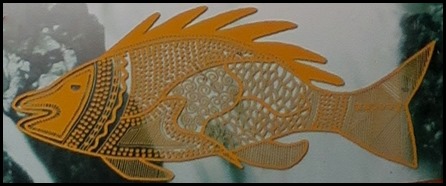 The Djabugay Bama (People)
remember through the stories of their ancestors a place in the past when the
great Rainbow Serpent Gudji Gudji came out from the sea.
The great serpent created all the
rivers, creeks and streams from Yaln.giri (Crystal Cascades) to Ngunbay (Place
of the Platypus, Kuranda) and gave special names to many of the places he
visited. There are those who believe
that snakes, eels, and oysters are his children, and the sound of thunder is his
voice.
  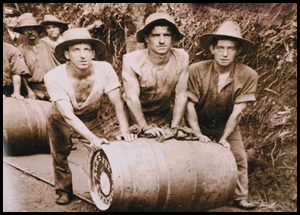 In July 1882, the search for a
suitable railway link from the Atherton Tableland to the coast was announced and
Christie Palmerston, bushman and explorer was commissioned to explore a suitable
railway route. With his erstwhile Bama mate and
assistant Pompo, they explored Barron Gorge and other valleys in the
region.
The going was tough, but Christie
and Pompo’s expert skills in locating and utilising the well established and
time trodden walking pads of the Bama proved fruitful in identifying a number of
possible options for the future railway. However, the railway route was still in doubt. There was a further two years
of surveying and re-surveying to find a way to conquer the
range.
The general finding of these
attempts were reflected in Christie Palmerston’s comments in his report to the
Government of the same year: “I am positive there is not a natural road
over the coastal range, or anything approaching it will require skill and
engineering wherever you wish to cross it”.
In March 1884, the time of the
year the Djabuganydji know as Gurrabana (wet season), the Government decided in
favour of the Barron Gorge route from Cairns. Working plans were completed and endorsed by Government on the 19th
of September 1885. Thus, the die had been caste and the future of Cairns was now
assured by the railway.
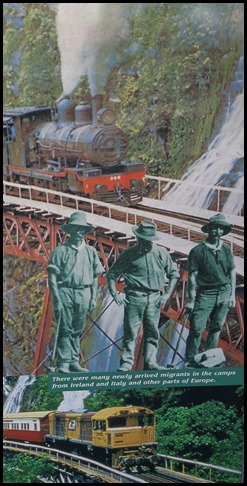 The Kuranda Scenic Railway winds
its way from the coast to the Tablelands, following in the path of the mighty
creation serpent, Budaadji the Carpet Snake, it brings people together, to new
and different places. Railway construction began in 1886 and at one stage some
fifteen hundred men were involved in the project and little townships flourished
along the route servicing the men and their families.
The line officially opened from
Cairns to Kuranda (Ngunbay) in June 1891, the time of the year when many
Djabuganydji would descend the mountain tracks with the forth-coming coastal
breezes to hunt, harvest and enjoy the many low land foods of the
season.
These were hard and arduous times
in our local history and many people died through disease, fever, conflict and
accident.
By hand and by cart these men dug
and shifted over 2.3 cubic million metres of rock and soil.
Today’s train ride has changed
little in its 100 odd years in operation. Marvelled at, and enjoyed by people
from around the world, it would seem appropriate to take a moment to acknowledge
and remember that this place of great natural beauty, is also a place of
cultural heritage significance.
A place that has seen thousands
of years of Aboriginal occupation and the sweat and toil of the early settlers
and their families. A place partaking in the spirit of the ancestors, their
story, ever present in the land.
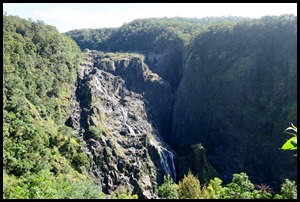 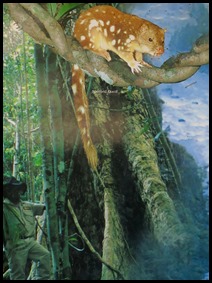 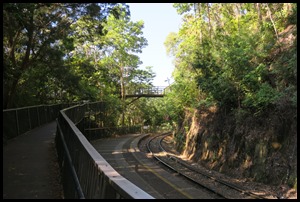 The Park is crisscrossed by a
series of natural and cultural corridors, some hidden and obscure. From here you
can see the corridors of recent human travel formed by the Skyrail cableway and
the Kuranda train line. But hidden beneath the forest canopy lie other
pathways – ancient walking tracks created by the Djabugay (pronounced Jaba-guy)
along the travel routes taken by their spiritual ancestors.
These same paths were used by
railway, mining and logging workers and now provide the masterplan for a network
of walking tracks throughout the Park. You are standing at the crossroads of an
ecological highway.
Wildlife needs corridors too and
the Barron Gorge National Park provides one of the
most significant in the Wet Tropics.
The Black Mountain Corridor,
including Barron Gorge National Park is a strip of protective forest only metres
wide in some places. It provides a vital link for birds and animals between the
northern and southern reaches of the Wet Tropics.
The rare southern cassowary, the
spotted quoll and Lumholtz’s tree-kangaroo are just a
few who travel this corridor in search of food and mates.
In the wet season natural forces
take control and the Barron Falls can be seen in its full splendour. For the
Djabugay it brings a physical reminder of the power of Gudju:Gudju the creator
being who they believed carved these spectacular chasms.
Mmmm, we think there is a bit too
much fluff in these signs, but it is good there is an attempt to honour the
Indigenous Peoples and their beliefs.
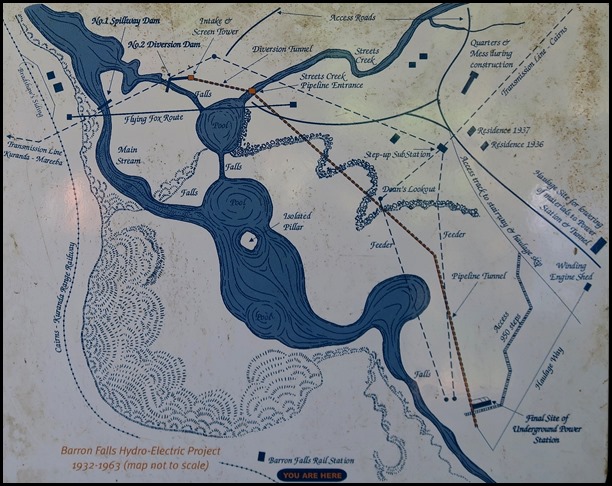 The Old Power Station: The two
concrete dams above Barron Falls were part of an earlier, smaller hydro-electric
power station built in the early 1930’s. The old power station was located on
the opposite side of the river, below the falls. Its construction was a huge
undertaking as it was subject to major flooding, and was built during the
Depression. This power station supplied power to Cairns and surrounds for almost
three decades.
During construction, a worker’s
camp was set up across the river and a trestle bridge was erected for access and
transfer of food supplies. Up to 105 men worked on the project at one time. It
was a formidable task; workers faced numerous rock falls and landslides as they
carved their way into the mountain to accommodate the power
station.
In 1963, the power station was
relocated downstream to its present site near the base of the gorge and is now
called the Barron Gorge Hydro, The old station is no longer
accessible.
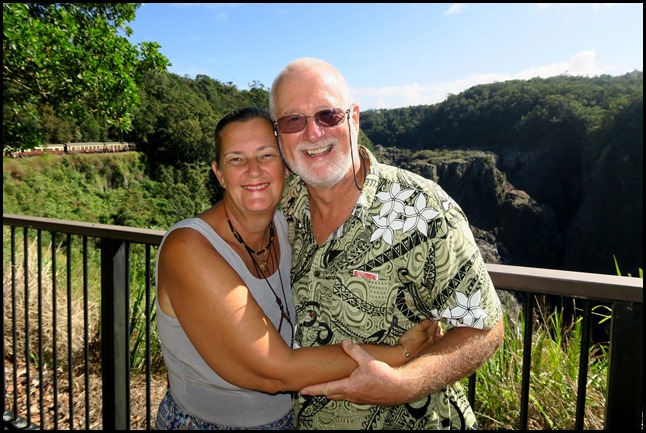 A kindly man took our picture and then it was time to board the train for
Kuranda.
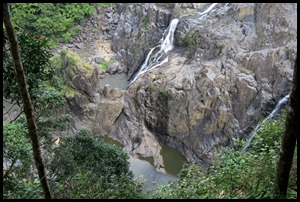 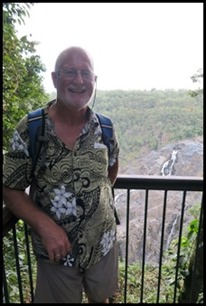  During our Skyrail ride we jumped off
at the Barron Gorge Lookout. More signs to read.
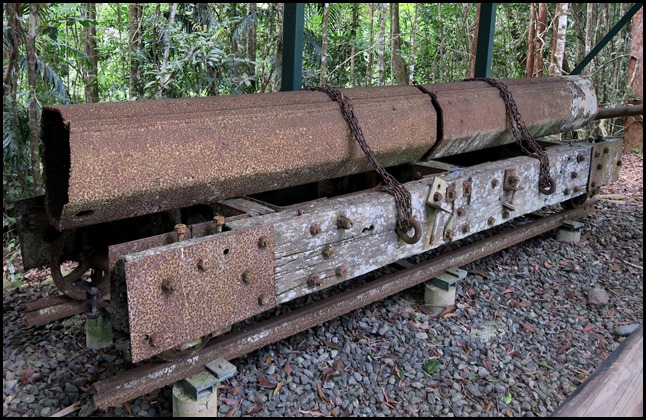 The haulage
trolley
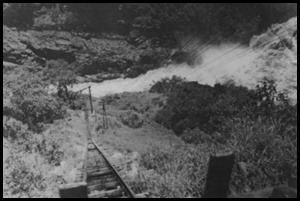  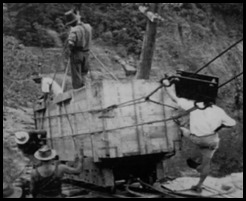 The original Barron Falls
Hydro-Electricity Station (1935-1963) was built under Skyrail’s Barron Falls
Station near the base of the Gorge. A haulage trolley was used to transport
materials and equipment down the tramline. The load
was secured to the trolley and lowered by two winches powered by a diesel engine
and an air compressor. A tramline, with
a two-foot gauge, running to the bottom of the Gorge was used to transport
workers and materials down the steep embankment to
the power station. A block and
tackle was used to lift the load from the trolley on to another tramline.
The load was then manually pushed into a nearby tunnel where it would be hauled
into the power station.
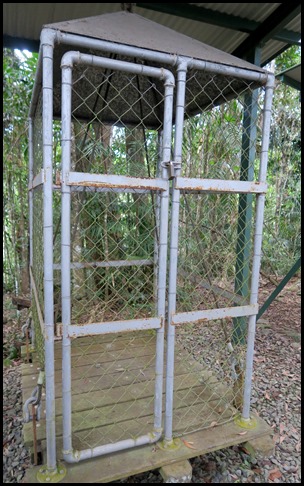 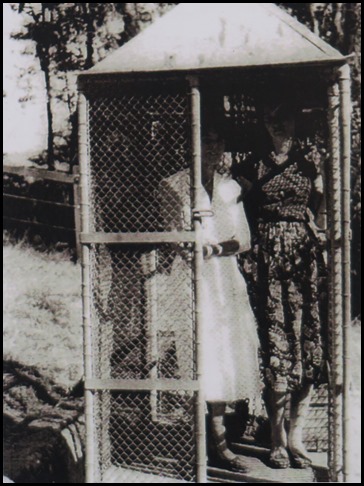 The Flying Fox: During the life
of the power station a flying fox was utilised to
carry men and materials across the Barron Falls. The flying fox was introduced
after three footbridges, spanning over the top of the falls, were washed away
during floods. The flying fox facility changed dramatically during its
use.
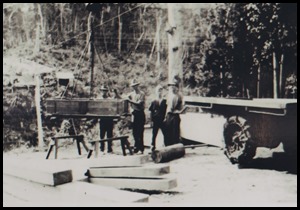 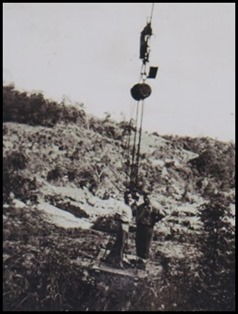 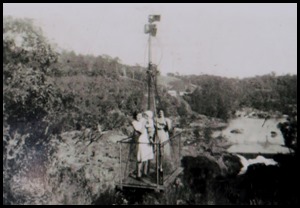 Short
sides were placed around the platforms to allow light materials and men
to be transported. A small platform suspended from a
chain block was utilised for the flying fox in the early years. A larger wooden platform with a pipe and wire fence was
introduced. Finally, an enclosed flying fox with a roof was utilised for
carrying passengers.
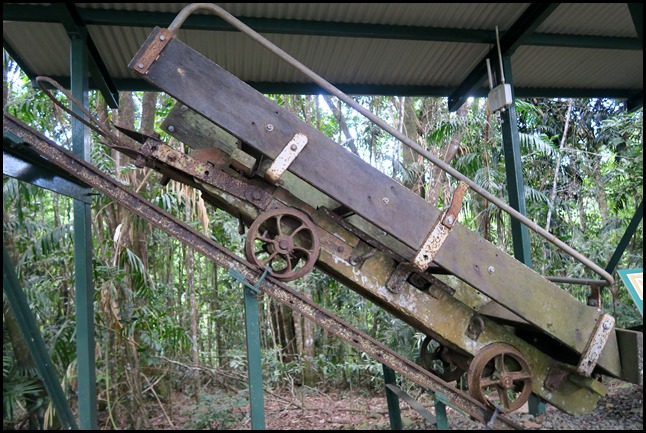 Personnel
trolley.
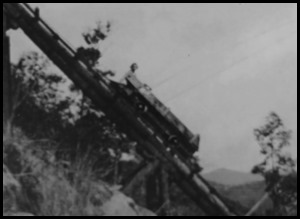 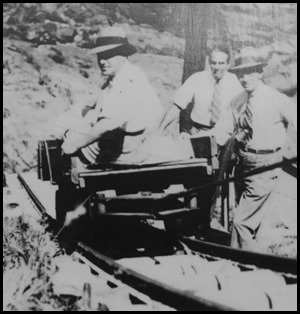 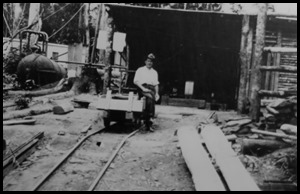 These images show the Barron
Falls Hydro-Electricity Station’s personnel trolley in
use. The trolley was capable of seating, without restraint, up to six
people. Passengers would travel up and down the steep gorge embankment to gain
access to the power station. To commence an ascent the trolley passengers would
ring a bell by depressing a button located under the tramline. The sounding of
the bell would be heard by the trolley driver located at the top of the
embankment and the passengers would be winched up the side of the Gorge. The
trolley driver would activate the trolley’s ascent by releasing the foot brake
and an air compressor would slowly pull-up the trolley with its passengers.
During some ascents the air compressor would lose pressure and leave passengers
stranded on the side of the embankment. The passengers would have to wit
patiently while the air compressor built
up enough pressure to allow them to recommence their journey. Who wrote
this stuff.......
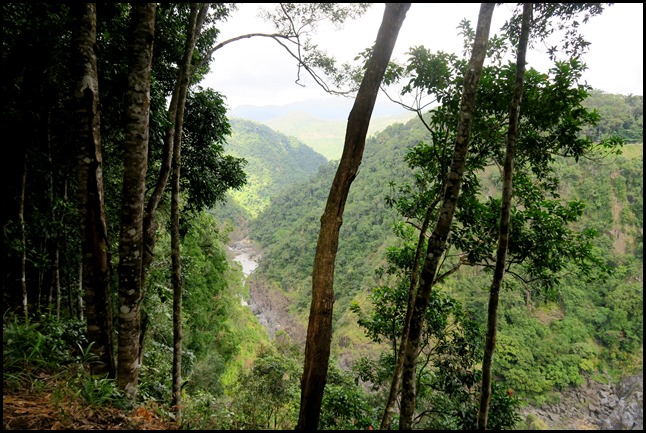 Looking down the
Gorge.
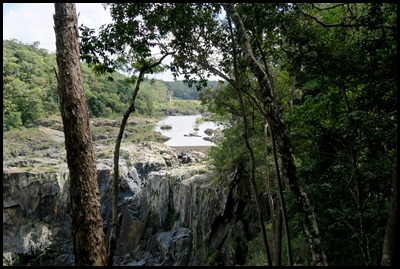 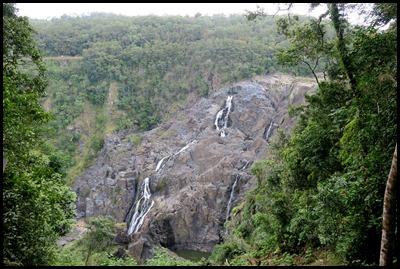 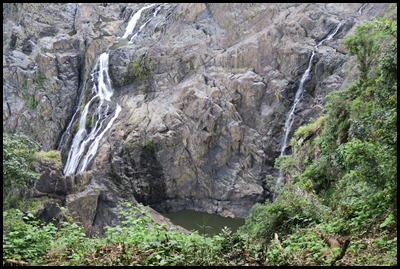  Views from the
Lookout.
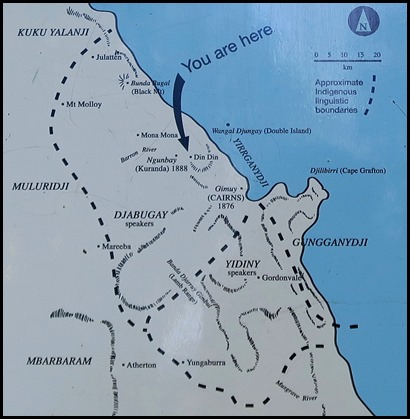 Local Indigenous
Speakers Map.
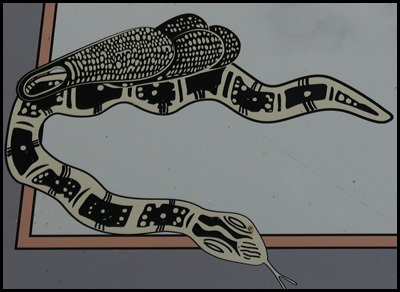  This place of great natural
beauty has a unique storied past, and holds great significance to the local
Aboriginal rainforest people (Djabuganydji Bama). All over Australia the Rainbow
Serpent is believed to have created rivers and creeks. Here Rainbow
(Gudju-Gudju), in the form of the Carpet Snake (Buda:dji or Wungul) is credited
with the creation of creeks all the way from Crystal Cascades (Yaln giri) to
Kuranda (Ngunbay – Place of the Platypus).
Buda:dji (carpet snake) laden with bright Miya-miya (nautilus shells) traversed the range to trade
yimbi’s (dilly bags) for his shells with the Tableland Bama. On of his journeys,
Buda:dji was followed by three bird men who wanted the shells for themselves.
When asked, Buda:dji refused to part with them, for in his mind they belonged to
the Tablelands People. The birds being greedy, ambushed Buda:dji and with
their stone axes, killed him and chopped him into pieces, throwing each piece
into the bush where they became a sacred part of the
landscape.
His sacred path is associated
with the significance of the Gurndal-gurndal (Stoney Creek), Mayila (Robb’s Monument).
Waalara (Surprise Creek) and Di:wungo (Stoney Creek Falls).
During Gurrabana (the Wet Season)
when Din Din is in flood, rainbows can be seen, reminding us all of the gifts of
Gudju Gudju and the destruction of Buda:dji, whose death was because of the
wanton greed of others.
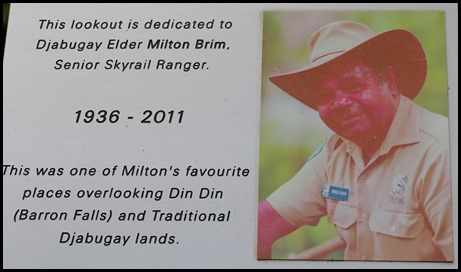 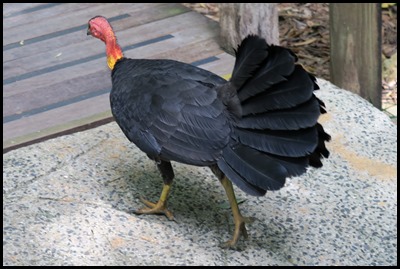 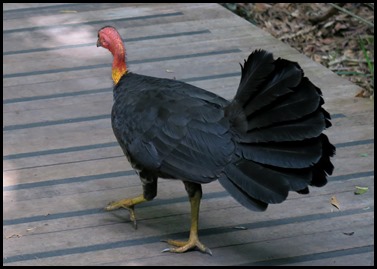 Our personal
guide back to the Skyrail.
ALL IN ALL AN INTERESTING
STOP
PRETTY SPECTACULAR
SCENERY |